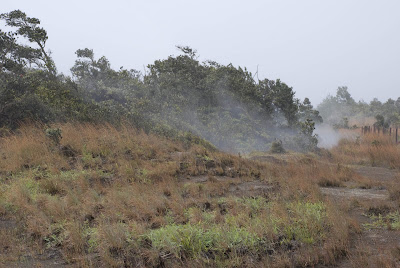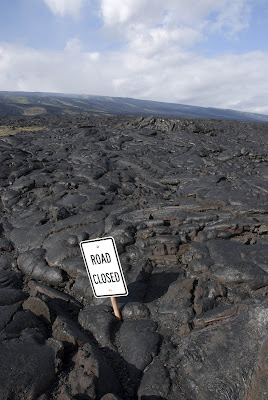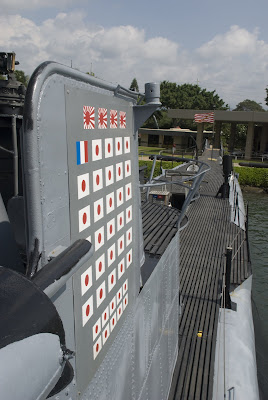
Growing up in Colorado, I've long been fascinated by geology. In some ways I think it ties into my love of history. After all, geology is the history of the earth, laid down in the rocks. If you can read the rocks, you can read back millions or even billions of years. While the study of history, human and Terran, is wonderful, sometimes it is nice to see history happen, to see things be made. I think that is one reason I had wanted to travel to Hawaii. The chance to see rocks that are younger than I am is a rare chance indeed!

On Halloween Megan and I flew from Honolulu to Hilo airport for a trip to Volcanoes National Park, the centerpiece of current activity on the Hawaiian Hot Spot. Interestingly enough, we were there in time to see a very interesting bit of science taking place. Volcanoes (traditionally) feed from a single magma chamber deep in the earth, and so (traditionally) erupt from one area at a time. While this eruptive vent can shift around the volcano, usually only one vent is active at any one time. At least, that was true before March of 2008. The vast caldera at the summit of Kilauea had been dormant since 1924, and the constantly spewing lava that the volcano is known for had moved to the east. Then, last March, a new vent in Halema‘uma‘u Crater (above) on the summit of Kilauea exploded. When we were there it was still erupting ash and noxious gases into the air, at the same time as vast amounts of lava flowed into the sea from another part of the volcano. Kilauea is the first volcano to erupt simultaneously from two separate vents, and you can imagine the geologists are busy little bees trying to figure it all out!

Near the summit is the Thurston Lava Tube, which was another amazing spectacle. Lava tubes are formed when erupting lava congeals on the surface of the flow, which protects and insulates the rest of the river of rock. When the eruption stops, the molten rock runs out of the worm tunnel it has created, leaving a very different sort of cave behind. Part of the Thurston tube is paved and well lit, and part of it isn't. Exploring the pitch black of unimproved tube was amazing, and a bit creepy.

Near the lava tube is Kilauea Iki crater, where in 1959 a vent nearby filled the area with a lake of lava. As the lava has cooled over the last 50 years, it has shrunk, cracking along the edges. The total lake was 400 feet deep, and by the year of my birth (1981) about half of it had solidified. It is totally safe to walk on, and in fact a trail leads around the edge of the crater, and out onto the surface of the lake.

Above the lake is the Devastated Area, where the Pu'u Pua'i vent that filled Kilauea Iki is located. The blasted landscape lives up to its name, with the area that used to be a road now covered in lava flows and cinders.

From there we drove down Chain of Craters Road, passing a plethora of recent lava flows, most from the 1970's and 80's. In fact, Chain of Craters Road used to pass out of the park along the coast, at least it did until 1986, when a huge flow covered the road.

And that is one of the things that is so fascinating about Kilauea. When I look at a piece of granite from Pikes Peak, that rock is billions of years old. But a shard of basalt from that 1986 flow was erupted in my lifetime, and that makes it much more immediate and easier to relate too. It's hard to understand the concept of a billion, but but 23 years is a number we can comprehend.

Of course, the craters, calderas, and past flows were all prologue. The real fireworks started at dusk, at the lava viewing overlook a little ways outside the park. If it is interesting to see flows that have erupted since my birth, how much better is it to see flows erupting at that very instant? The answer is "Very Interesting!" We were exceedingly lucky, Kilauea was feeling very active that day, and we had quite a show as the river of molten rock flowed into the ocean. Sometimes seawater will flow into the lava tube, and cold water and hot rock make an explosive combination!

As the sun set, we were treated to a real fireworks display put on by Mother Nature and Vulcan himself, complete with oooohing and ahhhhing from the spectators. It's almost hard to describe how I felt, except to say that I felt supremely lucky. I've seen three "active" volcanoes now, but to see an actual eruption, with lava and fountains of steam and ash, that's certainly not something you get to see every day, or even every lifetime.

It was an interesting walk back to the car, after all we were walking on uneven and sharp black rock, at night. Even with a flashlight, it wasn't easy. As we walked we could see the glow of the lava flowing further up the slopes of the volcano. The photograph is rather blurry, but it does offer a glimpse of what we saw. I promise next time I'll take my tripod!
This post was made possible by the generosity and sense of adventure of Megan, and was prepared with the armchair assistance of Roadside Geology of Hawai'i by Richard Hazlett and Donald Hyndman. If you are ever interested in the meaning behind the rocks you see, the Roadside Geology series is invaluable. I got this particular edition at the gift store in Volcanoes National Park, and it looks great on the shelf next to Roadside Geology of Colorado (I'm going to the Grand Canyon in May, so i suppose I will have to add Arizona to my collection!










